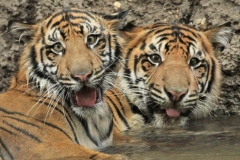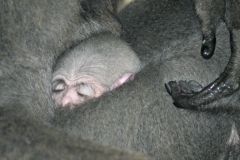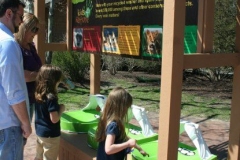![]()
News release from the Fort Wayne Children’s Zoo:
First-ever red panda cub born at zoo
A red panda cub was born at the Fort Wayne Children’s Zoo on May 31 to first-time mother Xiao (pronounced JOW), age 2, and her 3-year-old mate, Junjie. The cub is one of two in the litter. The second cub did not survive.
An endangered species, red pandas are difficult to breed and rear in captivity. About half of all cubs die within 30 days of birth. Only a few dozen red panda cubs are born in United States zoos each year.
This is the first red panda birth since the zoo began exhibiting red pandas in 1997.
“We are very excited about this birth, and we’re cautiously optimistic about the cub’s future,” said zoo keeper Helena Lacey, who is the red pandas’ primary caretaker. “But we know that these next few weeks are critical to the cub’s survival.”
Contact with Xiao and her cub is extremely limited to minimize stress on the mother and improve the cub’s odds of survival. For now, the pathway in front of the red panda exhibit is closed to zoo guests. Zoo staff have observed Xiao carrying her baby among several nest boxes in the exhibit, which is a normal behavior. The cub was removed from the nest for a brief exam yesterday. The cub squealed and appeared strong and healthy. It weighed just under five ounces.
Red panda cubs are born blind and deaf. The mother spends nearly all her time nursing and grooming her cubs during the first week. The cubs remain in the nest until they are about three months old.
“If the cub survives, zoo guests are not likely to see the cub out in the exhibit for several weeks or months,” says Lacey.
The breeding of red pandas is overseen by the Species Survival Plan (SSP), a program of the Association of Zoos & Aquariums (AZA). The goal of the SSP is to maximize genetic diversity in captive populations of endangered animals.
Red pandas are native to the forested foothills of the Himalaya Mountains in China and Nepal, where they feed primarily on bamboo. Though they share a name with the famed black-and-white giant pandas, the two are not closely related. The name “panda” comes from the Nepalese word ponya, which means “bamboo-eater.”
The Fort Wayne Children’s Zoo is northeast Indiana’s largest tourist attraction, hosting more than 500,000 guests annually. The zoo is consistently named one of the nation’s Top Ten Zoos for Kids by national media outlets.
As a self-supporting facility, the Fort Wayne Children’s Zoo receives no tax dollars for operations. The zoo’s operations are funded by earned revenue and donations.
The zoo is open April 21-October 14, 2012. Admission is $13.50 for adults; $10.50 for seniors age 60+; and $8.50 for children ages 2-14. Babies age 1 and under and Zoo Society Members are admitted free.
Fort Wayne Children’s Zoo website















